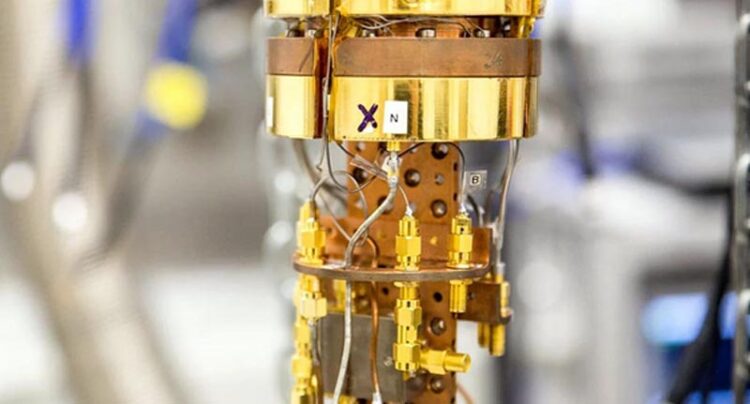Breakthrough in the understanding of quantum turbulence

The researchers used a unique rotating cryostat in their study
Credit: Mikko Raskinen/Aalto University
Researchers have shown how energy disappears in quantum turbulence, paving the way for a better understanding of turbulence in scales ranging from the microscopic to the planetary.
Dr Samuli Autti from Lancaster University is one of the authors of a new study of quantum wave turbulence together with researchers at Aalto University.
The team’s findings, published in Nature Physics, demonstrate a new understanding of how wave-like motion transfers energy from macroscopic to microscopic length scales, and their results confirm a theoretical prediction about how the energy is dissipated at small scales.
Dr Autti said: “This discovery will become a cornerstone of the physics of large quantum systems.”
Quantum turbulence at large scales – such as turbulence around moving aeroplanes or ships – is difficult to simulate. At small scales, quantum turbulence is different from classical turbulence because the turbulent flow of a quantum fluid is confined around line-like flow centres called vortices and can only take certain, quantised values.
This granularity makes quantum turbulence significantly easier to capture in a theory, and it is generally believed that mastering quantum turbulence will help physicists understand classical turbulence too.
In the future, an improved understanding of turbulence beginning on the quantum level could allow for improved engineering in domains where the flow and behaviour of fluids and gases like water and air is a key question.
Lead author Dr Jere Mäkinen from Aalto University said: “Our research with the basic building blocks of turbulence might help point the way to a better understanding of interactions between different length scales in turbulence.
“Understanding that in classical fluids will help us do things like improve the aerodynamics of vehicles, predict the weather with better accuracy, or control water flow in pipes. There is a huge number of potential real-world uses for understanding macroscopic turbulence.”
Dr Autti said quantum turbulence was a challenging problem for scientists.
“In experiments, the formation of quantum turbulence around a single vortex has remained elusive for decades despite an entire field of physicists working on quantum turbulence trying to find it. This includes people working on superfluids and quantum gases such as atomic Bose-Einstein Condensates (BEC). The theorised mechanism behind this process is known as the Kelvin wave cascade.
“In the present manuscript we show that this mechanism exists and works as theoretically anticipated. This discovery will become a cornerstone of the physics or large quantum systems.”
The team of researchers, led by Senior Scientist Vladimir Eltsov, studied turbulence in the Helium-3 isotope in a unique, rotating ultra-low temperature refrigerator in the Low Temperature Laboratory at Aalto. They found that at microscopic scales so-called Kelvin waves act on individual vortices by continually pushing energy to smaller and smaller scales – ultimately leading to the scale at which dissipation of energy takes place.
Dr Jere Mäkinen from Aalto University said: “The question of how energy disappears from quantized vortices at ultra-low temperatures has been crucial in the study of quantum turbulence. Our experimental set-up is the first time that the theoretical model of Kelvin waves transferring energy to the dissipative length scales has been demonstrated in the real world.”
The team’s next challenge is to manipulate a single quantized vortex using nano-scale devices submerged in superfluids.
Journal: Nature Physics
DOI: 10.1038/s41567-023-01966-z
Method of Research: Experimental study
Subject of Research: Not applicable
Article Title: Rotating quantum wave turbulence
Article Publication Date: 2-Mar-2023
COI Statement: n/a
Media Contact
Gillian Whitworth
Lancaster University
gillian.whitworth@lancaster.ac.uk
Office: 01-524-592-612
All latest news from the category: Physics and Astronomy
This area deals with the fundamental laws and building blocks of nature and how they interact, the properties and the behavior of matter, and research into space and time and their structures.
innovations-report provides in-depth reports and articles on subjects such as astrophysics, laser technologies, nuclear, quantum, particle and solid-state physics, nanotechnologies, planetary research and findings (Mars, Venus) and developments related to the Hubble Telescope.
Newest articles

First-of-its-kind study uses remote sensing to monitor plastic debris in rivers and lakes
Remote sensing creates a cost-effective solution to monitoring plastic pollution. A first-of-its-kind study from researchers at the University of Minnesota Twin Cities shows how remote sensing can help monitor and…

Laser-based artificial neuron mimics nerve cell functions at lightning speed
With a processing speed a billion times faster than nature, chip-based laser neuron could help advance AI tasks such as pattern recognition and sequence prediction. Researchers have developed a laser-based…

Optimising the processing of plastic waste
Just one look in the yellow bin reveals a colourful jumble of different types of plastic. However, the purer and more uniform plastic waste is, the easier it is to…


